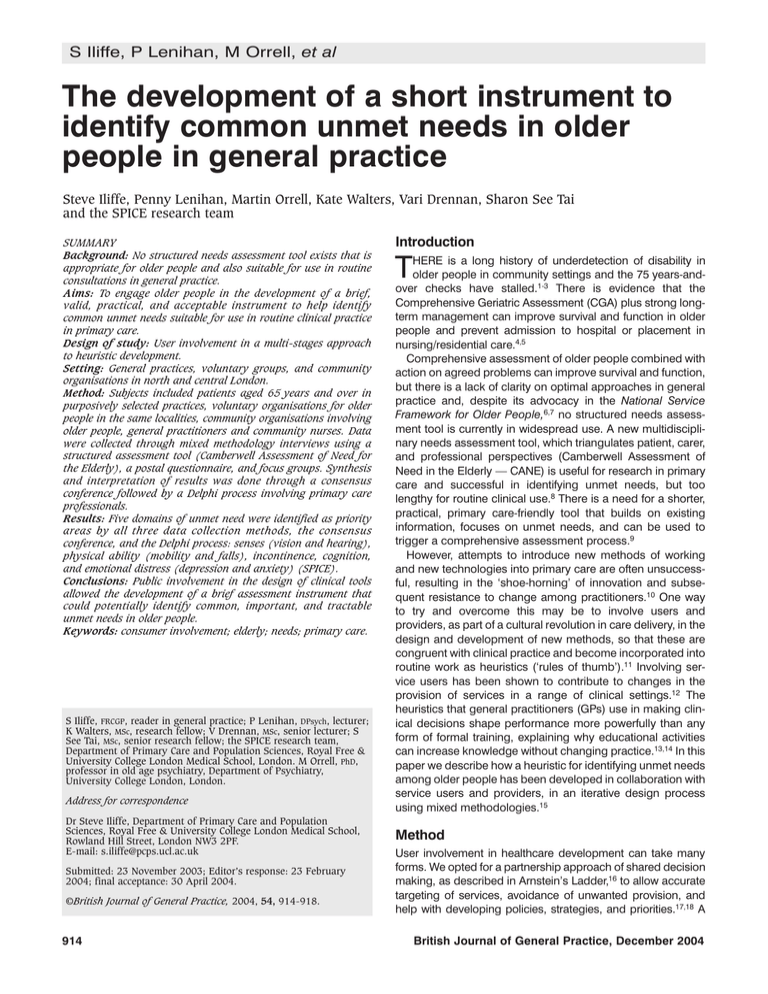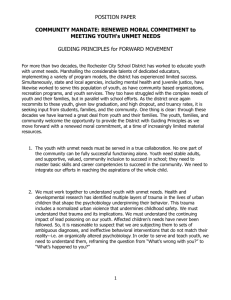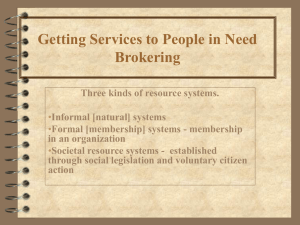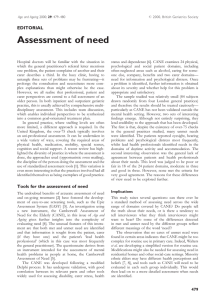The development of a short instrument to people in general practice
advertisement

S Iliffe, P Lenihan, M Orrell, et al The development of a short instrument to identify common unmet needs in older people in general practice Steve Iliffe, Penny Lenihan, Martin Orrell, Kate Walters, Vari Drennan, Sharon See Tai and the SPICE research team SUMMARY Background: No structured needs assessment tool exists that is appropriate for older people and also suitable for use in routine consultations in general practice. Aims: To engage older people in the development of a brief, valid, practical, and acceptable instrument to help identify common unmet needs suitable for use in routine clinical practice in primary care. Design of study: User involvement in a multi-stages approach to heuristic development. Setting: General practices, voluntary groups, and community organisations in north and central London. Method: Subjects included patients aged 65 years and over in purposively selected practices, voluntary organisations for older people in the same localities, community organisations involving older people, general practitioners and community nurses. Data were collected through mixed methodology interviews using a structured assessment tool (Camberwell Assessment of Need for the Elderly), a postal questionnaire, and focus groups. Synthesis and interpretation of results was done through a consensus conference followed by a Delphi process involving primary care professionals. Results: Five domains of unmet need were identified as priority areas by all three data collection methods, the consensus conference, and the Delphi process: senses (vision and hearing), physical ability (mobility and falls), incontinence, cognition, and emotional distress (depression and anxiety) (SPICE). Conclusions: Public involvement in the design of clinical tools allowed the development of a brief assessment instrument that could potentially identify common, important, and tractable unmet needs in older people. Keywords: consumer involvement; elderly; needs; primary care. S Iliffe, FRCGP, reader in general practice; P Lenihan, DPsych, lecturer; K Walters, MSc, research fellow; V Drennan, MSc, senior lecturer; S See Tai, MSc, senior research fellow; the SPICE research team, Department of Primary Care and Population Sciences, Royal Free & University College London Medical School, London. M Orrell, PhD, professor in old age psychiatry, Department of Psychiatry, University College London, London. Address for correspondence Dr Steve Iliffe, Department of Primary Care and Population Sciences, Royal Free & University College London Medical School, Rowland Hill Street, London NW3 2PF. E-mail: s.iliffe@pcps.ucl.ac.uk Submitted: 23 November 2003; Editor’s response: 23 February 2004; final acceptance: 30 April 2004. ©British Journal of General Practice, 2004, 54, 914-918. 914 Introduction HERE is a long history of underdetection of disability in older people in community settings and the 75 years-andover checks have stalled.1-3 There is evidence that the Comprehensive Geriatric Assessment (CGA) plus strong longterm management can improve survival and function in older people and prevent admission to hospital or placement in nursing/residential care.4,5 Comprehensive assessment of older people combined with action on agreed problems can improve survival and function, but there is a lack of clarity on optimal approaches in general practice and, despite its advocacy in the National Service Framework for Older People,6,7 no structured needs assessment tool is currently in widespread use. A new multidisciplinary needs assessment tool, which triangulates patient, carer, and professional perspectives (Camberwell Assessment of Need in the Elderly — CANE) is useful for research in primary care and successful in identifying unmet needs, but too lengthy for routine clinical use.8 There is a need for a shorter, practical, primary care-friendly tool that builds on existing information, focuses on unmet needs, and can be used to trigger a comprehensive assessment process.9 However, attempts to introduce new methods of working and new technologies into primary care are often unsuccessful, resulting in the ‘shoe-horning’ of innovation and subsequent resistance to change among practitioners.10 One way to try and overcome this may be to involve users and providers, as part of a cultural revolution in care delivery, in the design and development of new methods, so that these are congruent with clinical practice and become incorporated into routine work as heuristics (‘rules of thumb’).11 Involving service users has been shown to contribute to changes in the provision of services in a range of clinical settings.12 The heuristics that general practitioners (GPs) use in making clinical decisions shape performance more powerfully than any form of formal training, explaining why educational activities can increase knowledge without changing practice.13,14 In this paper we describe how a heuristic for identifying unmet needs among older people has been developed in collaboration with service users and providers, in an iterative design process using mixed methodologies.15 T Method User involvement in healthcare development can take many forms. We opted for a partnership approach of shared decision making, as described in Arnstein’s Ladder,16 to allow accurate targeting of services, avoidance of unwanted provision, and help with developing policies, strategies, and priorities.17,18 A British Journal of General Practice, December 2004 Original papers HOW THIS FITS IN What do we know? Identifying unmet need in older people can lead to gains in their health status and functioning. With limited time, health professionals in primary care cannot realistically perform full systematic needs assessments in general practice consultations. Unmet need among older people is limited in scale and range in community-dwelling populations. What does this paper add? Older people can contribute powerfully to the development of clinical heuristics (‘rules of thumb’). Five domains of unmet need have been identified by public and professional consensus as priority areas: senses, physical activity, incontinence, cognition and emotional distress (SPICE). The SPICE heuristic could be used as a useful prompt to opportunistic identification of unmet need in older people. triangulation of methods was chosen to optimise the generalisability of findings. The heuristic was developed in five stages: 1. Analysis of CANE data from 544 interviews. 2. A primary care user questionnaire survey with older people recruited from GPs’ lists. 3. Four nominal groups with older people and three with primary care professionals. 4. A consensus conference, including a series of workshops on developing and modifying the instrument. 5. A modified Delphi process with the steering group and primary care professionals. This staged approach progressively focuses on the research question (Figure 1).19 Each stage is described in detail below. Approval was obtained from the Camden and Islington Local Research Ethics Committee and the Barnet, Enfield and Haringey Local Research Ethics Committee. The research team The research team was made up of academic and service GPs, an old-age psychiatrist, a counselling psychologist, an academic primary care nurse, a medical sociologist, and two user representatives — one came from the local Age Concern group and the other from a local voluntary group for dementia care. Local voluntary organisations, Age Concern and Help the Aged, were consulted about the development of the research protocol. Apart from steering the project, the research team debated ways of minimising researcher biases in the methodologies employed. tify their own individual met and unmet needs. Items were ranked in order of frequency of unmet needs. Data were then grouped into different subcategories (sex; age groups: 65–74, 75–84, 85+ years; and primary care and other patient interview data samples) to investigate potential differences in highest ranked items and those that were consistently ranked highest among subcategories. Items highly ranked for primary care patients were given precedence if they differed greatly from the sample group as a whole. Associations between subcategories and highly ranked items were checked using χ2 tests in SPSS for Windows. The 10 highest ranked items were selected for the consensus conference. Postal questionnaire A postal questionnaire was developed by the study team with user involvement from the three user representatives on the research team, based on the list of needs recommended for the ‘single assessment process’ in the National Service Framework for Older People.7 It asked responders to rank the most important topics the GP or practice nurse should ask an older person about in a normal general practice consultation. This questionnaire asked participants’ opinions of the most important topics for older people in general, rather than to identify their own personal unmet health needs. It was piloted with service users attending a local Age Concern day centre, and refined before use. To optimise the diversity of the population surveyed by this method, four wards were purposively selected for their deprivation characteristics (high deprivation DETR index25 >0, medium deprivation DETR index -1 to 0, and low deprivation DETR index <-1), and ethnic mix. These wards were located in three London boroughs with a high percentage of the population aged 65 years and over. General practices located in each ward were identified through health authority databases and recruited to the study. The questionnaire was sent to a random sample of registered patients aged 65 years and over in each practice, stratified by age group (65–74, 75–84, 85+ years). The sample for those aged 85 years and over was selected on a 2:1 ratio, in comparison with the other samples, to increase representation of this ‘hard to reach’ group. Figure 1. Staged approach to the research question. Multidisciplinary research team with lay involvement Factor analysis of existing data User questionnaire survey with 200 older people Focus groups: older people (n = 4), professionals (n = 3) Assessment of needs using CANE The CANE is a comprehensive needs assessment tool for older people, which is suitable for use in a variety of settings.20 It identifies met and unmet needs and allows individual, carer, and staff rating. An unmet need may be indicated when the individual is not receiving an appropriate intervention or assessment. Data for CANE were available from community, sheltered housing, day hospital, and care home settings.21-24 For the CANE assessments, participants were asked to iden- British Journal of General Practice, December 2004 Multidisciplinary/lay consensus conference Delphi process Prototype brief instrument 915 S Iliffe, P Lenihan, M Orrell, et al Demographic data from the questionnaires were analysed to create a profile of responders. Proportions of patients who rated items on the questionnaire as very important or important were recorded, and these items were ranked from highest to lowest. Data were also subcategorised by sex, age group, living alone, and living in residential homes, to check for potential differences in rankings. Associations between highly ranked items and these subcategories were also checked using χ2 tests. Comparable items on CANE and the postal questionnaire were compared to see if they were consistently highly ranked. The top 10 ranked items were selected for the consensus conference. Group interviews using nominal group techniques Group interviews were held with users and providers using a nominal group technique, nominal groups being potentially powerful learning and development tools.26 They have a particular role in analysing healthcare problems and can help bridge the gap between researchers and practitioners.27,28 The exercise was conducted with seven purposively selected groups, each with 5–12 participants. Three groups consisted of healthcare professionals (two groups of GPs and one of practice nurses). Four groups were of older people, from a local Age Concern day centre, a community centre group, an Asian elders’ group, and an Afro-Caribbean elders’ organisation. A nominal group approach designed for ill-structured problems was chosen, to allow for disagreements over problem definition, and for potential solutions that overlapped or varied widely in specificity. This required the groups to generate ideas, confirm that they were addressing the same problem, analyse the content of the ideas, categorise ideas, and clarify the items in each category.29 Each group was asked to generate a priority list of important unmet needs (using their own experiences to guide them), that they felt would be appropriate to be introduced in a routine GP or practice nurse consultation with an older person. Unmet need was defined as a problem that an older person had that may be hidden or not immediately obvious to their doctor or nurse, and that had not been adequately addressed either by themselves, their family and friends, or professionals. Each group was cofacilitated by members of the research team who were experienced in nominal group methods, with an observer who attended all groups to take detailed notes. User groups were cofacilitated by a user representative on the research team. All groups worked in English, but the Asian elders’ group was also cofacilitated by a local representative who translated the discussion into Gujarati for participants who did not speak English. Group observers made field notes on the group processes as well as the discussion content. The groups were encouraged to summarise their discussions in a list of priority unmet need areas. The priority areas from each group were summarised for the consensus conference. Consensus conference Consensus conferences permit informed deliberation by experts about complex problems.30 The consensus conference included voluntary organisations, social care, housing, primary care, and user representatives. The results of the first three stages (CANE data, postal questionnaires, nominal groups) were circulated in advance to all participants, and 916 presented in the opening session of the conference. Four workshops followed, each tasked with identifying and ranking domains of unmet need using the presented data, but interpreted by workshop members’ experience. These domains had to be tractable (amenable to intervention), of high impact to individuals, and significant for health and social care. Workshops were conducted using nominal group rules,28,29 and ranked domains were written on flip charts for presentation in the plenary session. This session was used for a wholeconference debate on the domains, and a final selection and ranking process to produce a short list of unmet needs. Delphi process A single-stage modification of the Delphi process was used because it is a powerful way of obtaining a wider scope of anonymous expert opinion without the logistical problems of convening conferences.30 The final selection of domains was circulated to 30 GPs and 30 practice nurses in practices within the academic department’s network for promoting primary care for older people, for comment on their appropriateness and acceptability for use in primary care, amendment of meanings and content, and re-ranking. Practitioners were also asked to suggest questions that would be appropriate for each domain chosen. The responses from practitioners were then collated and synthesised by the research team. Results CANE interviews In all, 544 CANE interviews were analysed from four community and institutional studies using CANE. These were grouped into three patient samples: 311 (57.2%) community (primary care and sheltered housing) patients, 160 (29.4%) day hospital patients, and 73 (13.4%) care home residents. More were female (323 [59.4%]), and there were slightly more patients (237 [44%]) in the middle age band (75–84 years). There were no significant sex differences in each age band, or in each patient sample. Overall the five highest ranked unmet needs were memory, daytime activities, psychological distress, company, and mobility. Of the 10 highest ranked items across all responders (Table 1), there were no significant differences by sex, but significantly more patients in the oldest age group (85+ years) had unmet needs regarding mobility (χ2 = 26.5, 4 degrees of freedom [df], P<0.001), eyesight/hearing (χ2 = 29.6, 4 df, P<0.001), and accommodation (χ2 = 13.0, 4 df, P = 0.01) compared with the two younger age bands. Memory was the highest ranked item, which was heavily swayed by the residents of care homes, where 60 (82.2%) disclosed this as an unmet need. Comparing men and women in each age group separately did not disclose any new items requiring inclusion. Significantly more primary care patients had unmet needs regarding accommodation (χ2 = 20.9, 2 df, P<0.001), eyesight/hearing (χ2 = 33.2, 2 df, P<0.001), self-care (χ2 = 64.7, 2 df, P<0.001) and continence (χ2 = 20.1, 2 df, P<0.001). The primary care sample alone did not rank any new items higher than those ranked highest over all samples. Postal survey A total of 534 out of 1201 (44.5%) completed questionnaires British Journal of General Practice, December 2004 Original papers Table 1. Ranking of problems in CANE interviews and postal questionnaire responses. Problem area Hearing and vision Mobility Incontinence Memory Psychological distress Physical health Accommodation Daytime activities Information about health Self care Social contact/ company Intimate relationships Looking after the home Finances and benefits Pain control Managing medicines CANE interviews Postal questionnaire 7 5 9 1 3 – 6 2 5 3 1 7 8 10 2 – – 4 10 4 9 – 8 – – – – – – – 5 6 The problem domains are based on the list of needs recommended for the ‘single assessment process’ in the National Service Framework for Older People.7 Entries represent the top 10 priorities, where 1 = highest and 10 = lowest. CANE = Camberwell Assessment of Need for the Elderly. were returned. More questionnaires were from women (296 [55%]), and 226 responders (42%) were aged 65–74 years, 176 (33%) were aged 75–84 years, 118 (22%) were 85 years and over. Eighteen (3.4%) lived in care homes and 208 (39%) lived alone. A third of the responders (33.4%) were in receipt of income support benefit, indicative of very low income, 103 (19.3%) responders had carers, and 70 (13%) were carers themselves. Items concerning mobility (difficulties walking, climbing stairs, getting out and about, and falls) were ranked highest for the whole sample as well as in all subgroups of responders. Problems with medication (which was not in CANE) were highly ranked as were problems managing pain, which has no comparable item on CANE (although it is covered under physical health). Hearing problems were ranked highly by the two oldest age groups, those in care homes, and those living alone. Problems with going to the toilet were most important for men in the 65–74-year age group, men and women in the oldest age group (85+ years), and those living in care homes. indication of the process of health care rather than an individual need. The Delphi process deleted the domains ‘information’ and ‘accommodation’ from the final selection. The final selection of domains comprised: ‘senses’ (vision and hearing), ‘physical ability’ (mobility and falls), ‘incontinence’, ‘cognition’, and ‘emotional distress’ (depression and anxiety). The SPICE mnemonic was devised by the research team to summarise the final five domains in an easily memorable form that starts with the least sensitive domains, and includes 69% of the unmet health needs found in the earlier CANE studies.22-24 Discussion This study used a range of methods, with a mixture of professional disciplines and extensive user involvement to develop a simple heuristic that prioritises unmet needs in older people that can be addressed in primary care. Each of the methods used to elicit citizens’ views has limitations, which may bias our study findings. Simple ranking questionnaires are easy to devise and analyse, but are sensitive to question wording and prone to internal inconsistency and, alone, are of limited value.30 Nominal groups can produce superficial results, and are open to bias from professional and other interests with differing levels of authority; face-to-face interviewing is open to researcher bias.30 Similarly, consensus processes lack the time for reflection that may be needed to understand complex issues.30 However, when these different methods are combined together in a process of methodological triangulation, the errors of validity are reduced — this is the strength of this study. For example, potentially embarrassing or very personal themes (like incontinence or sexual relationships) may not be discussed in nominal groups but could be elicited in anonymous questionnaires or by in-depth discussion prompted by the full CANE. Our results would not have been obtained by seeking the opinions of small groups of GPs, as evidenced by the differences in priorities identified by different methods. The samples were broadly representative of the older London population rather than the United Kingdom as a whole, but this demographic limitation is also offset, at least to some extent, by the Figure 2. Unmet needs identified by nominal groups. Priorities identified by older people Nominal groups The domains prioritised by the nominal groups are shown in Figure 2. There were differences in perspective between professional groups and nominal groups of older people. For example, professionals identified ‘loneliness’ and ‘intimate relationships’ but these were not identified as highest priority areas to discuss in the general practice consultation by the user groups. At this level of analysis there were no differences between ethnic groups or professional disciplines. Consensus conference and Delphi process Table 2 shows the conclusions of the consensus conference. Mobility was ranked highest in the conference feedback session. Access to treatment was ranked highly in the workshops, but did not appear in the final feedback summary, as it was an British Journal of General Practice, December 2004 Information about health Priorities identified by both professionals and older people Memory, eyesight and hearing, physical health, medication use, psychological distress Accommodation, food preparation, self care, mobility, continence, alcohol use, loneliness, intimate relationships, money Priorities identified by professionals 917 S Iliffe, P Lenihan, M Orrell, et al Table 2. Consensus conference ranking of unmet need domains. Top 10 unmet need areas Memory Depression/mental distress Continence Mobility Vision and hearing Information: medical and social Accommodation Significant others/relationships General queries Looking after home Overall ranking 2 2 2 1 2 2 2 9 9 8 triangulated methodology and the consensus approach involving a wide process of consultation and consistent user involvement. In the National Service Framework for Older People front-line professionals in primary care are advised to ‘explore the further needs of older people they have contact with, beyond their immediate problem’.7 Mapping the needs of older people was also a key recommendation in the Audit Commission report The Coming of Age,31 and good-quality information to inform planning was cited as a central element in its recent report Forget Me Not.32 There is evidence that unmet needs are fewer than expected and cluster in particular domains.21 Nevertheless, lengthy assessment instruments that fit poorly into routine clinical practice may therefore be counterproductive, over-burdening practitioners and collecting information unnecessarily. This study has shown that a short assessment covering only five domains can be developed by users and providers, and is likely to be effective in identifying 69% of the unmet health needs in older patients in the community. This has implications for the overview assessment of the ‘single assessment process’.7 Thus, for primary care it may be more worthwhile to target particular domains rather than aim for a comprehensive but more time-consuming approach. Pietroni and colleagues urge a cultural revolution in engaging people in service design and reorganisation.11 This study demonstrates that involving older people in all stages of the development of a clinical tool is possible and creates an instrument with high content validity that is small enough to function as a memorable heuristic. A mixed methodology of involvement allows ‘hard to reach’ groups to be engaged, and public involvement alters the priority given to problems by clinicians. The SPICE heuristic has strong content validity but there is a need to test its feasibility and acceptability in primary care. References 1. Williamson J, Stokoe IH, Gray S, et al. Old people at home: their unreported needs. Lancet 1964; 13: 1117-1120. 2. Iliffe S, Haines A, Gallivan S, et al. Assessment of elderly people in general practice. 2. Functional abilities and medical problems. Br J Gen Pract 1991; 41: 13-15. 3. Iliffe S, Gould MM, Wallace P. Assessment of older people in the community: lessons from Britain’s ‘75 and over checks’. Rev Clin Gerontol 1999; 9: 305-316. 4. Stuck AE, Aronow HU, Steiner A, et al. A trial of annual in-home comprehensive geriatric assessments for elderly people living in the community. N Engl J Med 1995; 333(18): 1184-1189. 5. Stuck AE, Siu LA, Wieland AG, et al. Comprehensive geriatric assessment. Lancet 1993; 342: 1032-1036. 6. Wilkieson CA, Campbell AM, McWhirter MF, et al. Standardisation of health assessments for patients aged 75 years and over: 3 years’ experience in the Forth Valley Health Board. Br J Gen Pract 1996; 46: 307-308. 7. Department of Health. National Service Framework for Older People. 918 London: Department of Health, 2001. 8. Walters K, Iliffe S. CANE in primary care settings: its feasibility and utility as a research and clinical tool. In: Orrell M, Hancock G (eds). Needs assessment in older people: the Camberwell Assessment of Need for the Elderly. London: Gaskell, 2004. 9. Crome P, Phillipson C. Assessment of need. Age Ageing 2000; 29(6): 479-480. 10. May C, Gask L, Atkinson T, et al. Resisting and promoting new technologies in clinical practice: the case of telepsychiatry. Soc Sci Med 2001; 52(12): 1889-1901. 11. Pietroni P, Winkler F, Graham L. Cultural revolution. BMJ 2003; 326: 1304-1306. 12. Crawford MJ, Rutter D, Manley C, et al. Systematic review of involving patients in the planning and development of health care. BMJ 2002; 325: 1263. 13. Andersson SJ, Lindberg G, Troein M. What shapes GPs’ work with depressed patients? A qualitative interview study. Fam Pract 2002; 19(6): 623-631. 14. Andre M, Borgquist L, Foldevi M, Molstad S. Asking for ‘rules of thumb’: a way to discover tacit knowledge in general practice Fam Pract 2002; 19(6): 617-622. 15. Heathfield HA, Wyatt J. Philosophies for the design and development of clinical decision-support systems. Methods Inf Med 1993; 32(1): 1-8;9-17. 16. Arnstein SR. Eight rungs on the ladder of citizen participation. In: Cahn ES, Passett BA. Citizen participation: effecting community change. New York: Praeger, 1971. 17. Audit Commission. Listen up! Effective community consultation. London: Audit Commission, 1999. www.auditcommission.gov.uk/ reports/ACREPORT.asp?CatID=&ProdID=EA01768C-AA8E-4a2f-99DB83BB58790E34 (accessed 15 Oct 2004). 18. Milewa T, Valentine J, Calnan M. Managerialism and active citizenship in Britain’s reformed health service: power and community in an era of decentralisation. Soc Sci Med 1998; 47(4): 507-517. 19. Murphy E, Dingwall R, Greatbatch D, et al. Qualitative research methods in health technology assessment: a review of the literature. Health Technol Assess 1998; 2(16): iii-ix;1-274. 20. Reynolds T, Thornicroft G, Abas M, et al. Camberwell Assessment of Need for the Elderly (CANE). Development, validity and reliability. Br J Psychiatry 2000; 176: 444-452. 21. Walters K, Iliffe S, Tai SS, Orrell M. Assessing needs from patient, carer and professional perspectives: a feasibility study of the Camberwell Assessment of Need for the Elderly in primary care. Age Ageing 2000; 29(6): 505-510. 22. Field E, Walker M, Orrell M. The needs of older people living in sheltered housing. In: Orrell M, Hancock G (eds). Needs assessment in older people: the Camberwell Assessment of Need for the Elderly. London: Gaskell, 2004. 23. Ashaye OA, Livingston G, Orrell MW. Does standardised needs assessment improve the outcome of psychiatric day hospital care for older people? A randomised controlled trial. Aging Ment Health 2003; 7(3): 195-199. 24. Martin MD, Hancock GA, Richardson B, et al. An evaluation of needs in elderly continuing-care settings. Int Psychogeriatr 2002; 14(4): 379-388. 25. Copley K. DETR index of deprivation 2000. North Somerset, Research and development Council. http://www.google.co.uk/search?q=cache: QtPqbYD__8QJ:www.avon.nhs.uk/phnet/seminars/Better%2520Health %2520Forum%252010.10.2002.pdf+%22DETR+index%22&hl=en&ie= UTF-8 (accessed 15 Oct 2004). 26. Dockery G. Rhetoric or reality? Participatory research in the National Health service, UK. In: De Koning K, Martin M (eds). Participatory research in health: issues and experiences. London: Zen Books, 1996. 27. Van den Ven AH, Delbecq AL. The nominal group as a research instrument for exploratory health studies. Am J Public Health 1972; 62: 337-342. 28. Carney O, McIntosh J, Worth A. The use of the Nominal Group Technique in research with community nurses. J Adv Nurs 1996; 23(5): 1024-1029. 29. Bartunek JM, Murningham JK. The nominal group technique: expanding the basic procedure and underlying assumptions. Group and Organisation Studies 1984; 9: 417-432. 30. Ryan M, Scott DA, Reeves C, et al. Eliciting public preferences for healthcare: a systematic review of techniques. Health Technol Assess 2001; 5(5): 1-186. 31. Audit Commission. The coming of age; improving care services for older people. London: Audit Commission, 1997. 32. Audit Commission. Forget me not: mental health services for older people. London: Audit Commission, 2000. Acknowledgements Thanks to all those who participated in the nominal groups and consensus conference, and to the GPs and their patients who participated in the questionnaire study. The SPICE research team also includes: Dr Martin Harris, Horton Kennedy, Sybil Myerson, Frances Blitz, Dr Shoshana Cohen, and Trish Labro. The study was funded by Thames Region. British Journal of General Practice, December 2004




